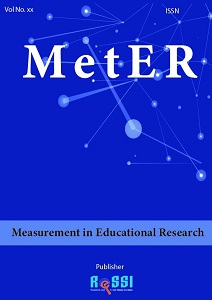Promoting EFL students' oral proficiency through the implementation of English Movies: A quasi-experimental research at Indonesia high school
DOI:
https://doi.org/10.33292/meter.v4i2.313Keywords:
English movies, impact, Oral proficienccy, promote,Abstract
This study investigates the impact of utilizing English Movies as a learning aid on students' oral proficiency in senior high schools in Indonesia. The research is an experimental study with a quasi-experimental design in a senior high school in Central Sulawesi, Indonesia. The research population consisted of all students of the Grade XI Science class. However, only two classes were selected purposively as the research samples: the Grade XI Science 1 class as an experimental group and the Grade XI Science 2 class as a control group. The number of the students were 22 and 24 respectively. With a probability value (p) for students' oral competency of p < 0.05, the research findings demonstrate a strong impact of learning aided by English movies on speaking abilities. In addition, the average score of students who utilized English Movies to enhance their speaking skills had a significant impact of 51.8182 compared to their counterparts in the control group, with an average score of 36.6667. In conclusion, the utilization of English Movies as a learning tool has a positive impact on promoting students' oral proficiency.
References
Albiladi, W. S., Abdeen, F. H., & Lincoln, F. (2018). Learning English through movies: Adult English language learners’ perceptions. Theory and Practice in Language Studies, 8(12), 1567. https://doi.org/10.17507/tpls.0812.01
Amiruddin, A., Satriani, S., Razaq, Y., Asyurah, S., & Nurhidayanti, N. (2022). Improving students’ speaking skills through continuous story technique with pictures. ETDC: Indonesian Journal of Research and Educational Review, 1(2), 162–168. https://doi.org/10.51574/ijrer.v1i2.333
Chaya, P., & Inpin, B. (2020). Effects of integrating movie-based mobile learning instruction for enhancing Thai University students’ speaking skills and intercultural communicative competence. English Language Teaching, 13(7), 27. https://doi.org/10.5539/elt.v13n7p27
Crisianita, S., & Mandasari, B. (2022). The use of small-group discussion to imrpove students’ speaking skill. Journal of English Language Teaching and Learning, 3(1), 61–66. https://doi.org/10.33365/jeltl.v3i1.1680
Heaton, J. B. (1998). Writing English test. Longman.
Ismail, N. M. (2017). “That’s the biggest impact!” Pedagogical values of movies in ELT classrooms. Studies in English Language and Education, 4(2), 216–225. https://doi.org/10.24815/siele.v4i2.6351
Jaya, H. P., Petrus, I., & Pitaloka, N. L. (2022). Speaking performance and problems faced by English major students at a university in South Sumatera. Indonesian EFL Journal, 8(1), 105–112. https://doi.org/10.25134/ieflj.v8i1.5603
Kalra, R. (2017). The effectiveness of using films in the EFL classroom: A case study conducted at an International University in Thailand. SSRN Electronic Journal, 8(3), 1–23. https://doi.org/10.2139/ssrn.3053569
Madiyoh, R., & Putro, N. H. P. S. (2018). The effectiveness of authentic short movies in enhancing students speaking skill. International Journal of English Literature and Culture, 6(3), 44–49. https://doi.org/10.14662/IJELC2018.030
Manik, H., & Salamuddin, S. (2023). The effectiveness of watching movie of students’ speaking ability at the twelfth grade of MAN Singkil. Education & Learning, 3(1), 34–40. https://doi.org/10.57251/el.v3i1.733
Nuansari, H., & Sriyanto, W. (2021). The effectiveness of using animation movie in improving speaking skills of elementary students. ELLTER Journal, 2(1), 47–52. https://doi.org/10.22236/ellter.v2i1.5368
Pan, B. A., & Snow, C. E. (1999). The development of conversation and discorse skills. In The development of language (1st ed., p. 21). Psychology Press.
Safira, L., & Azzahra, N. (2022). Meningkatkan kesiapan kerja lulusan SMK melalui perbaikan Kurikulum Bahasa Inggris. https://doi.org/10.35497/558654
Saleem, M., & Zahid, Z. (2024). Implications of English animated movies on speaking skills of the EFL learners. Pakistan Languages And Humanities Review, 8(III), 24–36. https://doi.org/10.47205/plhr.2024(8-III)03
Sari, D. S., Astuti, D. S., & Ramadhiyanti, Y. (2023). Analisis kesulitan keterampilan bahasa Inggris peserta Kejar Paket C di Satuan Pendidikan Non Formal (SPNF) Sanggar Kegiatan Belajar (SKB). Jurnal Pendidikan Bahasa, 11(2), 468–477. https://doi.org/10.31571/bahasa.v11i2.4914
Suzuki, S., & Kormos, J. (2020). Linguistic dimensions of comprehensibility and perceived fluency: An investigation of complexity, accuracy, and fluency in second language argumentative speech. Studies in Second Language Acquisition, 42(1), 143–167. https://doi.org/10.1017/S0272263119000421
Uzzaman, M. A., & Roy, S. (2019). Learning English through watching movies. NAEM Journal, 14(21), 7–19.
Yamada, M. (2010). English as a multicultural language: implications from a study of Japan’s junior high schools’ English language textbooks. Journal of Multilingual and Multicultural Development, 31(5), 491–506. https://doi.org/10.1080/01434632.2010.502967
Yanagi, M., & Baker, A. A. (2016). Challenges experienced by japanese students with oral communication skills in Australian Universities. TESOL Journal, 7(3), 621–644. https://doi.org/10.1002/tesj.229







